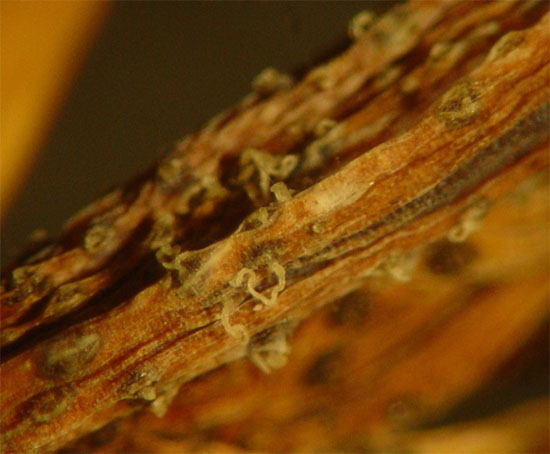Issue 2, May 4, 2015
Phomopsis Cankers
There are a number of species of Phomopsis fungi which cause cankers on a wide variety of hosts. The most common ornamental hosts include juniper, red cedar, Russian olive, and holly. The cankers usually begin as small, dead areas on the branches and shoots. As the disease progresses, the cankers coalesce until they girdle the branch. All tissue past that point will die, leading to tip blight and dieback.
The fungus overwinters in cankers on infected plants. Infection resumes in spring due to the wet environmental conditions which favor the production and spread of spores. Wounds, including pruning cuts, are an effective point of entry for the fungus. Reinfection can occur repeatedly during the growing season if favorable conditions continue.

Phomopsis on juniper. Tendrils of spores are exuded from overwintering fruiting structures under wet conditions. Photo credit: University of Illinois Plant Clinic.
Phomopsis cankers are often associated with stressed plants and are rarely fatal on their own. However, they damage the aesthetics of the host and further increase the amount of stress on the host. Stressed plants are more susceptible to pathogens and pests, and less able to repair damage caused by biotic and abiotic factors.
Already this year the Plant Clinic has received samples of juniper, holly, and kerria plants with Phomopsis cankers. On herbaceous stems the cankers often appear as round or oblong dark brown to black lesions. The center of the lesions may be a lighter color, darkening as the surrounding plant tissue dies.

Phomopsis cankers on Kerria. Note that the shoot on the left is almost completely affected, while the shoot on the right is less so. Photo credit: Diane Plewa / University of Illinois Plant Clinic.
On woody plants, the cankers may be more difficult to see. Look for sunken areas with a darker margin. You may be able to find cankers by looking at the area of the branch between the healthy and the affected leaves or needles. The sapwood under the bark is usually dark brown or black, indicating tissue death. On junipers and red cedars, the most common symptom of Phomopsis is tip dieback.
Management for Phomopsis cankers focuses on cultural techniques. Because the fungus does not overwinter in the soil, pruning and destroying infected shoots or branches is an effective way to reduce the amount of the fungus in the landscape. When installing plants, space them appropriately to allow for good air movement. Larger plants can be pruned to increase air movement and allow for more thorough drying of plant tissue. Fungicides with the active ingredient thiophanate-methyl are recommended for use against this disease. Ensure that any fungicide you plan to use is labeled for use on the host plants you are treating. (Diane Plewa)
Author:
Diane Plewa